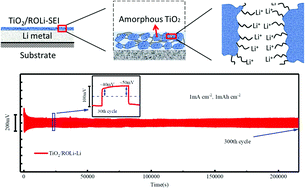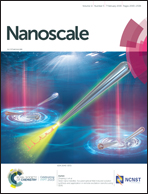An artificial TiO2/lithium n-butoxide hybrid SEI layer with facilitated lithium-ion transportation ability for stable lithium anodes†
Abstract
Fabricating an artificial solid electrolyte interphase (SEI) layer on a lithium metal surface has become an available strategy to prevent highly active lithium directly contacting the organic electrolyte, which could avoid the spontaneous formation of an inhomogeneous and unstable SEI film on the lithium surface. However, the poor Li-ion transport capability of the traditional SEI films greatly limited the application of the artificial SEI for lithium metal anodes. In this work, we proposed an artificial TiO2/lithium n-butoxide hybrid SEI layer with facilitated Li-ion transport ability to enhance the cycling stability of lithium metal anodes. The artificial SEI film is mainly composed of amorphous titanium dioxide and lithium n-butoxide (ROLi, R = C4H9) which were in situ formed on the lithium metal surface via the hydrolytic process of tetrabutyl titanate. The obtained SEI exhibited not only efficient mechanical strength but also facilitated Li-ion transport ability, ensuring the long cycling stability of the lithium metal anode. As a consequence, the symmetrical battery with a TiO2/ROLi–Li electrode showed outstanding electrochemical performance in terms of a low potential hysteresis of 50 mV and long cycling stability over 600 hours with a flat voltage plateau. Li–LiFePO4 full cells also show greatly improved electrochemical performance with a high capacity retention of ∼100% for 200 cycles and a high capacity of 140 mA h g−1 at 0.5C.



 Please wait while we load your content...
Please wait while we load your content...